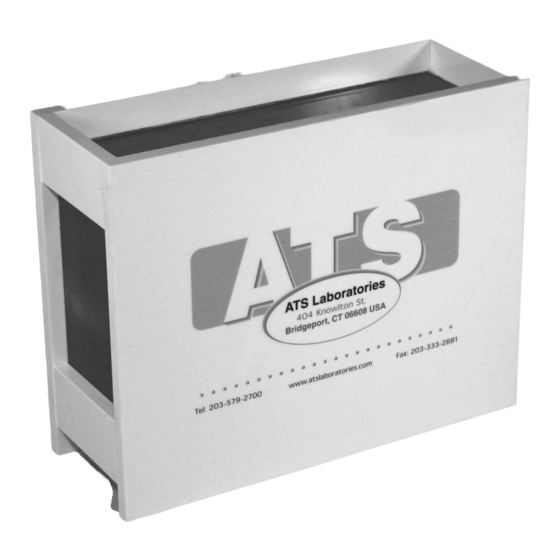- ページ 8
ラボラトリー機器 ATS 570のPDF 取扱説明書をオンラインで閲覧またはダウンロードできます。ATS 570 13 ページ。 Multipurpose - endoscopic phantom

1. Position the transducer over the horizontal group of line targets until a clear image is obtained. Freeze the
image.
2. Using the electronic calipers or the timing markers measure the greatest distance that can be clearly imaged
between line targets displayed.
3. Note: Some sector scanners have distance markers on the outside edges of the sector image with no other
indicators available. Hand-held calipers must be used for distance measurements within the image on the
monitor.
4. Document all of the measurements on the quality assurance record.
Results
The system's horizontal distance measurements should remain consistent from week to week when using the
same instrument settings and Model 570 phantom. Compare the test results obtained from the baseline records.
If the current image demonstrates changes in the system's ability to resolve these targets, corrective action
should be considered.
AXIAL – LATERAL RESOLUTION ARRAYS (E1, E2 & E3)
Description and Reason For Testing
Resolution is the minimum reflector separation between two closely spaced objects which can be imaged
separately along the axis of the beam, whereas lateral resolution defines the system's ability to image objects
separately that lie perpendicular to the axis of the sound beam. If a system has poor resolution capabilities, small
structures lying close to each other will appear as one image, causing improper interpretation of the ultrasound
findings. Axial Resolution depends on the transducer's center frequency, damping characteristics and pulse
length. Generally, the higher the frequency the better the system's axial resolution. Lateral Resolution depends
on the beam width, focusing characteristics of the transducer, number of displayed scan lines and the system's
sensitivity and gain settings.
Testing Procedure
The locations in the phantom are referenced from the first axial target.
The line targets are spaced at 5.0, 4.0, 3.0, 2.0, 1.0 mm intervals both axially and laterally. The last point of the
axial array target group is also the first target point in the lateral array group.
1. Position the transducer over the axial-lateral resolution group of line targets on the phantom until a clear
image is obtained. Freeze this image.
2. Examine the image to determine if all of the line targets within the group are clearly displayed as separate
target points. Record the closest spaced target points which can be imaged (refer to specification drawing).
Obtain a hard copy of the display.
3. Document all observations made on the quality assurance record.
Results
The system's ability to resolve the array targets at given depths should remain consistent from week to week
when using the same instrument settings and Model 570 phantom. Compare the test results obtained from the
baseline records. If the current image demonstrates changes in the system's ability to resolve these targets,
corrective action should be considered.
FOCAL ZONE (B1 & B2)
Description and Reason For Testing
The focal zone is the region surrounding the focal point in which the intensity and the lateral resolution is the
greatest. Clinically, structures examined within the focal zone will provide the best diagnostic information
obtainable. The focal zone can be affected by changes in the pulsing/receiving section of the imaging system or
damage to the transducer.
Testing Procedure
1. Position the transducer over the vertical group of line targets on the phantom, until a clear image is obtained.
A line rather than a dot is produced on the display. The length of the line is indicative of the width of the beam.
Therefore, targets inside the focal zone form a shorter line than those outside of the focal zone. Adjustments
8
